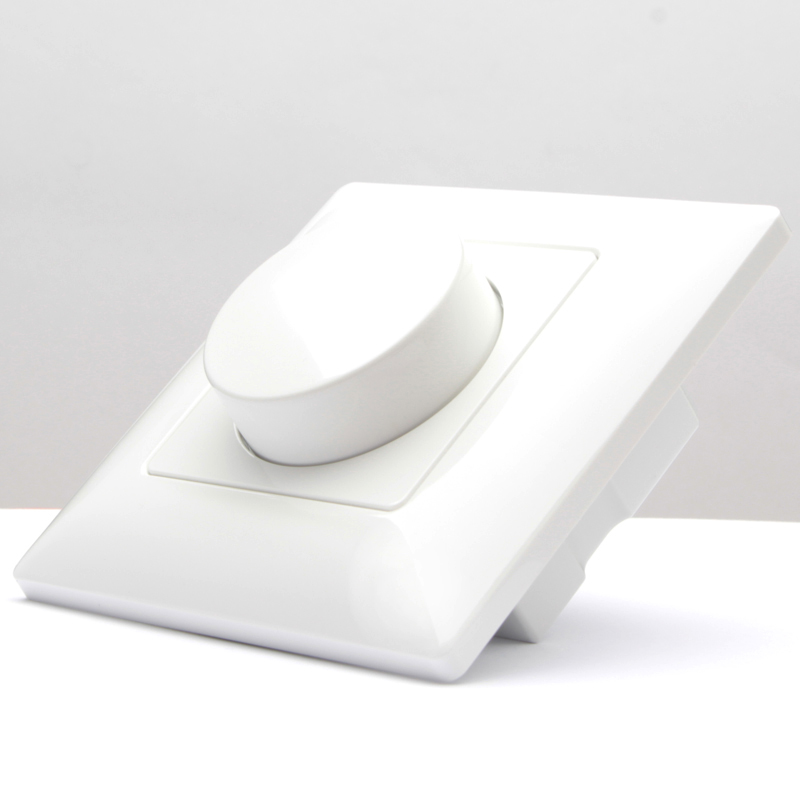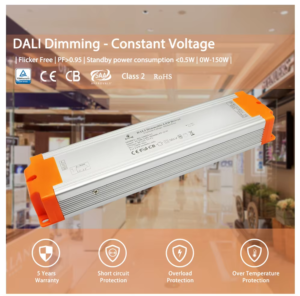Einführung
Hallo zusammen! Als jemand, der jahrelang die Beleuchtung von Gebäuden optimiert hat, weiß ich aus erster Hand, wie wichtig eine effektive Beleuchtungssteuerung ist. Wie wirkt sich das 0-10V-Dimmen auf die Beleuchtungsleistung Ihrer Einrichtung aus? Lassen Sie uns in die Details dieser Technologie eintauchen und sehen, wie sie in Ihrer Einrichtung einen großen Unterschied machen kann.
0-10V Dimmen Übersicht
0-10-V-Dimmen ist eine Methode zur Steuerung der Helligkeit von LED-Leuchten durch Veränderung der Spannung zwischen 0 und 10 Volt. Dieses unkomplizierte System ermöglicht einen reibungslosen Dimmvorgang und hilft Einrichtungen, Energie zu sparen und die Beleuchtungsstärke anzupassen. Trotz seiner Vorteile können Kompatibilitätsprobleme mit verschiedenen Dimmern und Treibern eine Herausforderung darstellen. Aber wie alles hat auch dieses Gerät seine Tücken - Kompatibilitätsprobleme mit verschiedenen Dimmern und Treibern können Kopfzerbrechen bereiten.
- Einführung
- 0-10V Dimmen Übersicht
- Verstehen von 0-10V Dimmen
- Was sind die Vorteile des 0-10V-Dimmens?
- Was ist das Problem beim Dimmen mit 0-10 V?
- Was ist der größte Nachteil der Steuerung verschiedener Leuchtengruppen mit einem 0-10-V-Dimmsystem?
- Verringert das Dimmen von LED-Leuchten den Stromverbrauch?
- Vergleich mit anderen Dimmverfahren
- Energieeinsparungen und Auswirkungen auf die Wartung
- Einschlägige Normen und Vorschriften
- Zusammenfassung
Verstehen von 0-10V Dimmen
Beim 0-10-V-Dimmen wird ein Niederspannungs-Gleichstromsignal (DC) verwendet, um die Intensität von Beleuchtungskörpern zu steuern. Dieses System funktioniert nach einem einfachen Prinzip: Wenn die Spannung sinkt, wird die Lichtleistung gedimmt. Bei einer Spannung von 10 Volt arbeitet die Leuchte mit voller Helligkeit. Wenn Sie die Spannung auf 0 Volt verringern, wird das Licht allmählich gedimmt, bis es seine Mindesthelligkeit erreicht oder ganz ausgeschaltet wird.
This method of dimming is one of the earliest and simplest forms of lighting control, making it a popular choice in many commercial and industrial facilities. Its simplicity lies in the analog nature of the control—there's no complex digital processing involved, just a straightforward adjustment of voltage that results in a corresponding change in light intensity.
Einer der Hauptgründe für die weite Verbreitung des 0-10-V-Dimmens ist seine Zuverlässigkeit und die einfache Integration mit verschiedenen Arten von Beleuchtungskörpern, insbesondere LED-Leuchten. Es ist ein vielseitiges System, das in verschiedenen Umgebungen eingesetzt werden kann, von Bürogebäuden und Lagerhallen bis hin zu Einzelhandelsflächen und Produktionsstätten.

Was sind die Vorteile des 0-10V-Dimmens?
Die 0-10V-Dimmung bietet eine Reihe von Vorteilen, die Ihnen das Leben sehr erleichtern können:
- Reibungsloser Dimmvorgang: Dieses System ermöglicht einen reibungslosen Betrieb bei verschiedenen Lichtstärken, einschließlich 10%, 1% und sogar 0,1%. Es geht um Flexibilität - ob Sie helles Licht für detaillierte Arbeiten oder ein weicheres Licht für die Atmosphäre benötigen, mit der 0-10-V-Dimmung sind Sie bestens gerüstet.
- Energieeinsparungen: Indem wir die Lichtintensität herunterregeln, wenn die volle Helligkeit nicht benötigt wird, können wir eine Menge Energie sparen. Das bedeutet niedrigere Stromrechnungen und einen geringeren ökologischen Fußabdruck - eine Win-Win-Situation.
- Verbessertes Ambiente: Die Möglichkeit, das Lichtniveau an die jeweiligen Bedürfnisse anzupassen, kann die gesamte Umgebung erheblich verbessern. Ob es darum geht, die Produktivität in einem Arbeitsbereich zu steigern oder eine gemütliche Atmosphäre in einem Lounge-Bereich zu schaffen, die richtige Beleuchtung macht den Unterschied.
- Verlängerte Lebensdauer von Beleuchtungskörpern: Der Betrieb der Leuchten bei niedrigeren Pegeln reduziert die Belastung der LEDs, verlängert ihre Lebensdauer und senkt die Wartungskosten.
Was ist das Problem beim Dimmen mit 0-10 V?
Ich will es nicht beschönigen: 0-10 V Dimmen ist nicht perfekt. Hier sind ein paar Schluckauf Sie in laufen könnte:
- Mangelnde Standardisierung: Das größte Problem ist das Fehlen eines vollständig standardisierten Ansatzes, was zu ungleichmäßigem Dimmen bei verschiedenen LED-Leuchten führen kann. Es ist ein bisschen so, als würde man versuchen, Fernbedienungen verschiedener Marken mit einem Fernseher zu verwenden - nicht immer ein reibungsloses Erlebnis.
- Kompatibilitätsprobleme: Schlechte Kompatibilität zwischen Dimmern und Treibern kann zu häufigen Auswechslungen führen, die Verzögerungen und zusätzliche Kosten verursachen. Das ist frustrierend, aber mit der richtigen Planung und den richtigen Produkten können wir diese Hindernisse in der Regel umschiffen.
- Anforderungen an die Verdrahtung: Eine ordnungsgemäße Verkabelung und Installation sind entscheidend für die korrekte Funktion des Systems. Dies kann die anfängliche Einrichtung komplizierter machen, aber wenn es erst einmal installiert ist, sind Sie glücklich.
Was ist der größte Nachteil der Steuerung verschiedener Leuchtengruppen mit einem 0-10-V-Dimmsystem?
Der größte Nachteil ist hier die Kompatibilität zwischen verschiedenen Standards (IES-Norm 60929 Anhang E und Standard ESTA E1.3). Diese Inkompatibilität bedeutet, dass Dimmer möglicherweise nicht mit allen Treibern richtig funktionieren, was zu einer uneinheitlichen Dimmleistung und potenziellen Wartungsproblemen führt. Es ist ein bisschen mühsam, aber das Verständnis dieser Normen kann uns helfen, von Anfang an die richtigen Komponenten auszuwählen.

Verringert das Dimmen von LED-Leuchten den Stromverbrauch?
- Energieeinsparung: Ganz genau. Je heller eine LED ist, desto mehr Energie verbraucht sie. Gedimmte LEDs verbrauchen also weniger Energie, was nicht nur die Betriebskosten senkt, sondern auch unsere Nachhaltigkeitsziele unterstützt. Es ist so, als würde man die Lautstärke der Lautsprecher herunterdrehen - man hört immer noch den Sound, nur nicht mehr in voller Lautstärke.
Vergleich mit anderen Dimmverfahren
Vergleichen wir das Dimmen mit 0-10 V mit einigen anderen gängigen Methoden:
- Triac-Dimmen vs. 0-10V-Dimmen: Die Triac-Dimmung wird häufig für Glühbirnen und Halogenlampen verwendet und funktioniert durch Unterbrechung von Teilen der Wechselstromwelle, um die Lichtleistung zu verringern. Im Gegensatz dazu eignet sich die 0-10-V-Dimmung besser für LED-Systeme und bietet eine sanftere und präzisere Steuerung.


- 1-10V Dimmen vs. 0-10V Dimmen: Das 1-10-V-Dimmen ist zwar ähnlich, wird aber typischerweise in Europa verwendet und hat etwas andere Spannungsbereiche und Steuerungsmethoden. Beide Methoden bieten ähnliche Vorteile, aber es ist wichtig, dass Sie diejenige wählen, die mit den Anforderungen Ihres Systems kompatibel ist.

In der folgenden Tabelle werden die Dimmmethoden 0-10V, 1-10V und TRIAC verglichen:
| Feature | 0-10V Dimmen | 1-10V Dimmen | TRIAC-Dimmen |
|---|---|---|---|
| Steuersignal Typ | Analog, Niederspannung DC (0-10V) | Analog, Niederspannung DC (1-10V) | Digital, AC-Phasensteuerung |
| Typischer Anwendungsfall | LED-Beleuchtung in Gewerbe und Industrie | LED-Beleuchtung, üblicherweise in Europa | Glühbirnen, Halogen- und einige LED-Leuchten |
| Spannungsbereich | 0 bis 10 Volt | 1 bis 10 Volt | Einstellung des Phasenwinkels der AC-Versorgung |
| Dimmbereich | Sanftes Dimmen von 100% auf 0% | Sanftes Dimmen von 100% auf etwa 10% | Sanftes Dimmen von 100% bis nahe 0% |
| Komplexität der Installation | Mäßig, erfordert kompatible Verkabelung | Mäßig, erfordert kompatible Verkabelung | Gering, nutzt vorhandene Verkabelung |
| Kompatibilität | Kompatibel mit den meisten handelsüblichen LED-Treibern | Häufig in bestimmten Regionen verwendet (Europa) | Kompatibel mit den meisten herkömmlichen Glühbirnen und einigen LEDs |
| Energie-Effizienz | Hoch, geeignet für energiesparende Anwendungen | Hoch, geeignet für energiesparende Anwendungen | Mäßig, weniger effizient bei LEDs im Vergleich zum analogen Dimmen |
| Fragen der Standardisierung | Einige Kompatibilitätsprobleme zwischen verschiedenen Marken | Weniger Standardisierungsprobleme in Regionen, in denen sie verwendet werden | Standardisiert, allgemein verständlich |
| Kosten | Mäßig | Mäßig | Gering bis mäßig |
| Sanftes Dimmen | Sehr gleichmäßig, gut für unterschiedliche Lichtverhältnisse | Glatt, darf aber nicht unter 10% abdunkeln | Reibungslos, aber bei einigen LEDs kann es zu Flackerproblemen kommen |
| Gemeinsame Anwendungen | Büros, Lagerhallen, Einzelhandelsflächen | Ähnlich wie 0-10V, aber mehr regional | Wohngebäude, kleinere Gewerbeflächen |
| Wartungsbedarf | Gering, erfordert aber eine sorgfältige Auswahl der Komponenten | Gering, erfordert aber eine sorgfältige Auswahl der Komponenten | Geringe, unkomplizierte Wartung |
Energieeinsparungen und Auswirkungen auf die Wartung
- Energieeinsparung: Dimmen kann zu erheblichen Energieeinsparungen führen, wodurch die Betriebskosten und die Umweltbelastung gesenkt werden. Indem wir weniger Energie verbrauchen, können wir einen nachhaltigeren Betrieb erreichen.
- Wartung: Die Lebensdauer von LED-Leuchten lässt sich durch den Betrieb mit reduzierter Leistung verlängern, was den Wartungsbedarf und die Kosten senkt. Weniger häufige Auswechslungen und Reparaturen bedeuten weniger Ausfallzeiten und weniger Unterbrechungen Ihres Betriebs.
Einschlägige Normen und Vorschriften
Die Einhaltung einschlägiger Normen wie der IES-Norm 60929 Anhang E und ESTA E1.3 gewährleistet optimale Leistung und Konformität. Die Kenntnis dieser Normen hilft uns bei der Auswahl kompatibler Komponenten und der Erzielung der besten Ergebnisse mit Ihrem Dimmersystem.
Zusammenfassung
Zusammengefasst, 0-10V Dimmen kann die Beleuchtungsleistung Ihrer Einrichtung durch Energieeinsparungen, anpassbare Lichtstärken und eine längere Lebensdauer der Leuchten erheblich verbessern. Um optimale Ergebnisse zu erzielen, müssen jedoch Kompatibilitätsprobleme beachtet und Normen eingehalten werden. Die Berücksichtigung dieser Faktoren kann Ihnen helfen, ein effizientes und effektives Beleuchtungssteuerungssystem zu implementieren.
Wenn Sie also darüber nachdenken, die Beleuchtung Ihrer Einrichtung aufzurüsten, ist das 0-10-V-Dimmen definitiv eine Überlegung wert. Es hat seine Tücken, aber mit der richtigen Einrichtung und ein wenig Know-how kann es einen großen Unterschied machen. Wenn Sie Fragen haben oder Hilfe benötigen, um die beste Lösung für Ihre Einrichtung zu finden, zögern Sie nicht, sich an mich zu wenden - ich bin für Sie da!
Wir sind boqi, das hat 0-10V dimmbare LED-Treiber und kompatibel 0-10V Dimmer.








